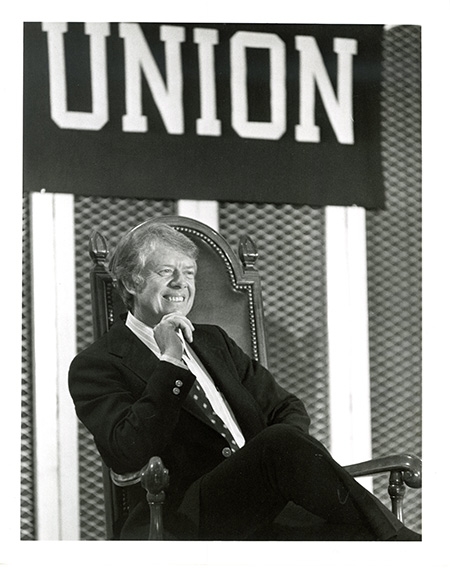In the spring of 1953, a young Navy lieutenant named Jimmy Carter stepped foot on Union’s campus for the first time. The year before, Admiral Hyman Rickover had selected Carter for an elite nuclear submarine program.
As the senior officer for the pre-commissioning of the USS Seawolf, the country’s second nuclear submarine, Carter arrived in Schenectady as part of a team working with General Electric and the nearby Knolls Atomic Power Laboratory.
Part of the training included Carter taking special non-credit classes in reactor technology and nuclear physics at Union. He also helped tutor the men under his command who were taking courses at the College contracted by the Navy.
“We took the enlisted men from simple fractions through differential equations within a year,” he wrote in his 1976 memoir, “Why Not The Best?” The title refers to the time when Rickover asked Carter, who had applied for assignment in the submarine program, why he had not always done his best as a cadet at the Naval Academy.
“We all thoroughly combined our theoretical studies with daily practical applications of our knowledge in the building of the first nuclear propulsion components.”
Over the weekend, Carter entered home hospice care after multiple hospital stays, the Carter Center announced. The news has prompted a national reflection on the 98-year-old’s legacy and nostalgic remembrances from those who had an association with the former president, including Union.
In 1953, Professor Frederick A. Klemm was the head of the College’s extension division, which offered courses for the submarine program.
“He was a very personable officer, completely devoted to the Navy and to the men under his command,” Klemm later recalled of his interactions with Carter on campus. He died in 2010.
“He was a man who ran a tight ship with an understanding for the human side of the problems involved in the complexities of submarine service.”
Carter’s time on campus was brief – he resigned from the Navy in October 1953 to take over the family peanut business following the death of his father – but it fostered a lifelong connection to the College that both parties promoted.
When the former Georgia governor ran for president in 1976, Carter included his short time at Union in his official bio, which brought welcome attention to the College. The media commonly overstated the connection, claiming he studied “graduate nuclear physics at Union College.”
Days before the New York presidential primary in April, Carter included Union as a campaign stop. The headline on a College press release stated, “Jimmy Carter, Former Union Student, Returns to College…”
Speaking to a full house inside Memorial Chapel on a Friday afternoon (another 300 who couldn't get in stood outside), Carter called the campus “one of the most beautiful in the country.”
He recalled the academic rigor of the nuclear program at Union, saying, “I’ll never forget the difficulty of those assignments, nor the rapidity with which I was taught nuclear physics and mathematics.”
He also presented Klemm with an 8x10 photo of himself, signing it, “Thanks to my good friend Frederick Klemm.”
Rudy Lu ’77 attended the campaign rally as a photographer for the Concordiensis. He remembers the Secret Service inspecting his camera. He was impressed that Carter’s speech emphasized that technology and engineering were the wave of the future.
“I was just awestruck that he was visiting,” Lu said.
A newswire service story proclaimed, "Carter visits his alma mater, Union College, for a triumphant homecoming."
When Carter improbably won the presidency in November 1976, Union President Thomas Bonner sent a telegram to the president-elect:
“Warmest congratulations from your second alma mater, Union College. You are the first of those who have studied at Union to ascend to the presidency since Chester Arthur in 1881. All of us at Union are proud of you today. On behalf of the entire College, I wish you all success in the great task that lies ahead.”
He also reiterated a verbal invitation he made during the April visit to have Carter speak at Commencement in June 1977. While honored by the request, Carter said he was unable to make a commitment so far in advance.
Carter never stepped foot on campus again. Yet 70 years after he and his wife, Rosalyn, and their three sons relocated to Schenectady for a brief period, his obituary inevitably will mention his time at Union. It is still listed on the Carter Center website.
After all, as Carter told the audience during his visit to campus in April 1976, “I’ve always had a very close feeling for you.”


